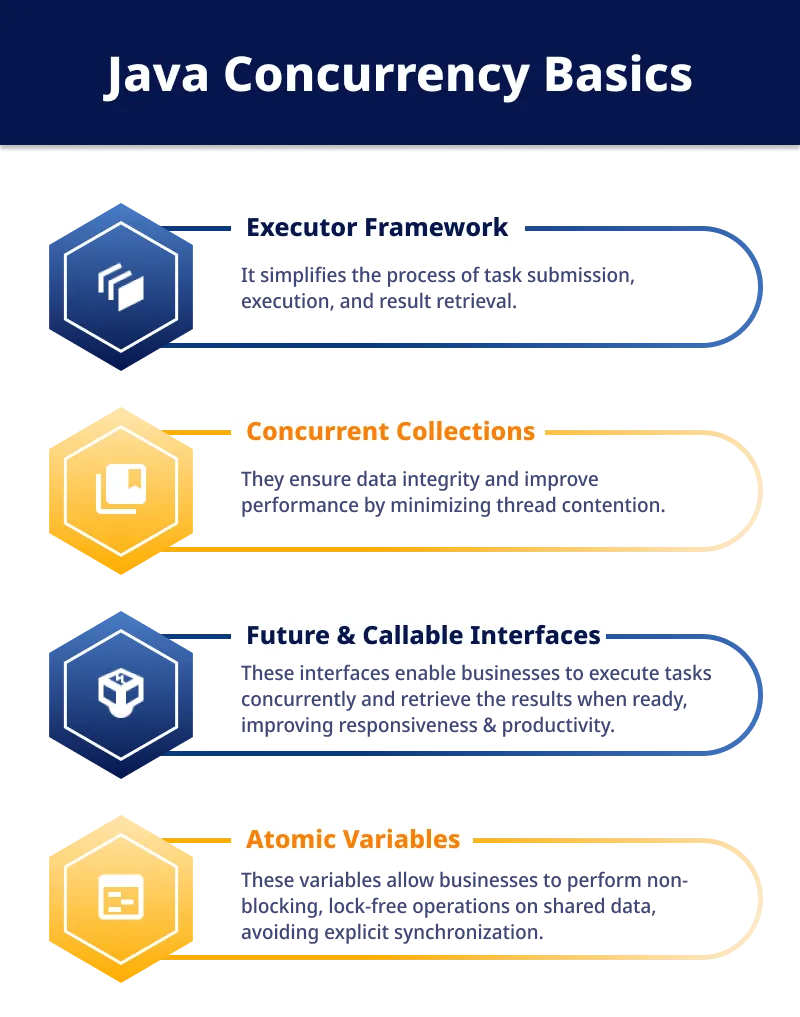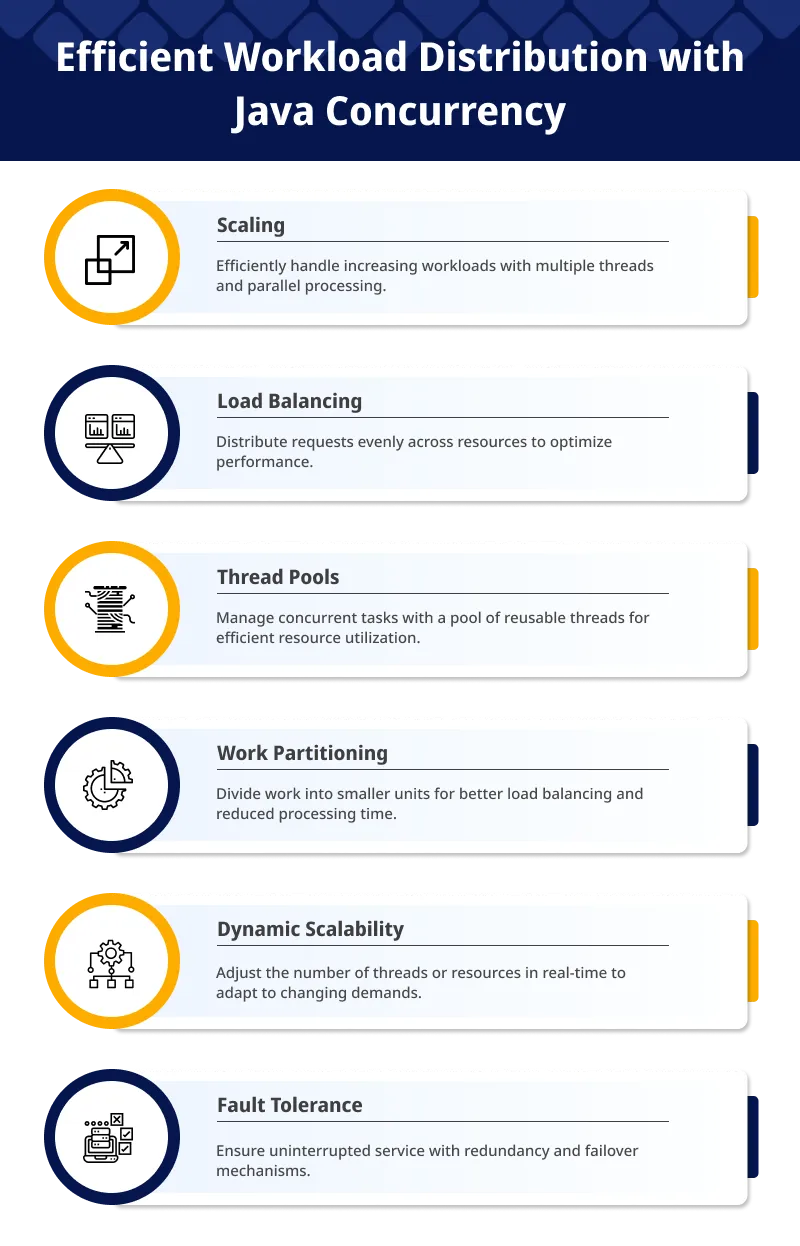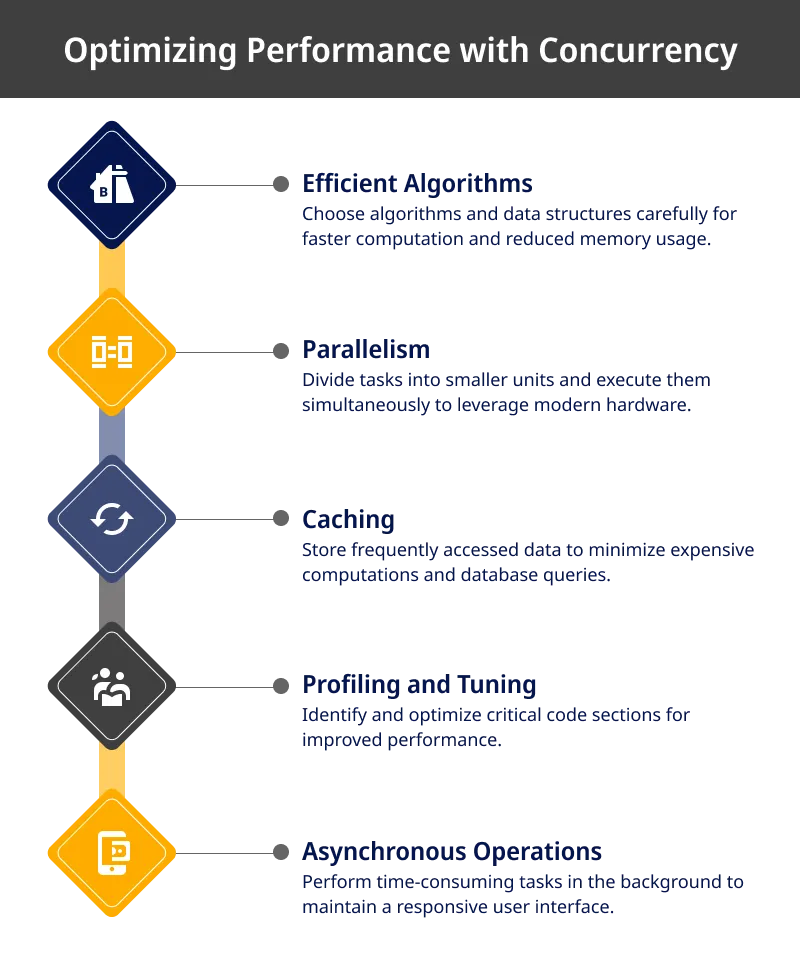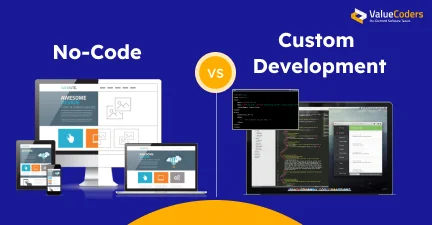Are you tired of sluggish and unresponsive Java applications that just can’t seem to keep up with the demands of modern computing?
Mastering Java concurrency is all you need to enliven your application. By efficiently utilizing multiple threads and optimizing your code for parallel execution, you can gain a significant competitive advantage in performance.
Moreover, it was stated by a large-scale study on the usage of Java’s concurrent programming constructs shows that Java programming language is vibrant regarding concurrent programming constructs.
To help you understand this better, we’ll explore the ins and outs of Java concurrency in this blog post.
From basic concepts to advanced techniques that will help take your application’s speed and responsiveness to the next level.
So let’s dive in to boost your app’s performance.
Understanding Java Concurrency Basics
Java concurrency is about juggling multiple tasks simultaneously, like a skillful multitasker.
Imagine you have a to-do list with several items, and instead of doing them one by one, you can tackle them concurrently, saving time and increasing efficiency.
This is exactly what Java concurrency allows you to do in your programs.
In Java, a program can have multiple threads, each representing an independent worker carrying out a specific task.
Threads act like superheroes, performing their tasks simultaneously and speeding up the overall execution. It’s like having a team of workers collaborating to get things done faster.
Creating threads in Java is as easy as summoning new team members. You can extend the thread class or implement the runnable interface to define the tasks that each thread will execute.
It’s like assigning different responsibilities to each team member, ensuring they work together harmoniously.
But there’s a catch: Things can get messy when multiple threads access shared resources or variables.
Just imagine two team members trying to write on the same whiteboard simultaneously. To maintain order and prevent conflicts, Java provides synchronization mechanisms.
Synchronization acts like a referee, ensuring only one thread can access a shared resource. It keeps things organized and prevents chaos.
By leveraging Java concurrency, you can unleash the true power of your programs. It allows you to divide and conquer complex tasks, tackle computations in parallel, and maximize your system’s resources.
Get in touch with ValueCoders.
Concurrency Challenges for Businesses
Concurrency in Java can introduce a unique set of challenges for businesses. Let’s explore some of these challenges:
- Performance Bottlenecks: As concurrent tasks increase, businesses must ensure their applications can handle the load efficiently. Bottlenecks may arise when multiple threads contend for shared resources, causing delays and hampering overall performance. It’s like a traffic jam in your software!
- Data Integrity and Synchronization: Maintaining data integrity becomes crucial when multiple threads concurrently access and modify shared data. Conflicts & inconsistencies can occur without proper synchronization mechanisms, leading to incorrect results or data corruption.
- Deadlocks and Race Conditions: Deadlocks creep in when threads get stuck waiting for resources held by other threads, resulting in a standstill. Race conditions arise when the output of a program becomes dependent on the relative ordering of thread execution.
- Debugging and Testing Complexity: Testing and debugging concurrent applications require specialized techniques and tools to identify issues like thread interference, synchronization errors, or incorrect thread communication.
A java website development company can help you leverage your Java concurrency. Whether you’re building a high-performance application or aiming to improve responsiveness, Java concurrency empowers you to achieve your goals efficiently.
Key Java Concurrency Utilities for Businesses
Java offers a range of powerful concurrency utilities that serve as valuable tools for businesses to enhance their software applications.
Some of these critical Java concurrency utilities:
- Executor Framework: With the Executor framework, you can focus on defining tasks while leaving the thread management to Java. It simplifies the process of task submission, execution, and result retrieval.
- Concurrent Collections: Concurrent collections are like synchronized containers that enable safe and efficient access to shared data in a multi-threaded environment. These ensure data integrity and improve performance by minimizing contention among threads.
- Future & Callable Interfaces: Future represents the result of an asynchronous computation, while Callable represents a task that can return a result. These interfaces enable businesses to execute tasks concurrently and retrieve the results, improving responsiveness and productivity.
- Atomic Variables: Atomic variables, such as AtomicInteger and AtomicReference, provide thread-safe atomic operations and guarantee consistency. These variables allow businesses to perform non-blocking, lock-free functions on shared data, avoiding the need for explicit synchronization.
With the support of Java development services, you can harness the benefits of Java concurrency utilities and dodge the common pitfalls of concurrent programming.
Also read: What Is Java Used For? 9 Things You Can Create
Enhancing Business Performance with Java Concurrency
By leveraging the power of concurrency in Java, businesses can unlock a world of possibilities and significantly improve their software applications.
Here is how concurrency enhances performance:
- Faster Execution: Java concurrency allows tasks to run concurrently, enabling businesses to achieve shorter execution times. By breaking down complex operations into smaller, concurrent tasks, it gets easier to utilize the full potential of your hardware resources and reduce overall processing time.
- Parallel Computations: With Java concurrency, businesses can leverage parallel computations to handle large datasets and complex calculations more efficiently. Distribute the processing power and achieve substantial performance gains by dividing the workload across multiple threads or processes.
- Multi-threaded Task Execution: Concurrent programming in Java allows businesses to execute multiple tasks concurrently, improving responsiveness and user experience.
- Scalability and Resource Utilization: Java concurrency empowers businesses to scale their applications effectively. Hire app developers to utilize multi-core processors and distributed systems efficiently. Businesses can also handle increasing workloads without sacrificing performance.
- Efficient Background Processing: With concurrent programming, businesses can offload time-consuming tasks to background threads, making the main thread responsive and user-friendly. This enables businesses to provide seamless user experiences while performing resource-intensive operations in the background.
So, it’s time to unlock the power of Java concurrency and unleash the full potential of your business, delivering exceptional software solutions that drive success.
Let Java experts at ValueCoders do it for you.
Scaling & Load Balancing with Java Concurrency
Let’s dive into how concurrency in Java can help businesses scale and balance their workload effectively.
- Scaling: Java concurrency enables businesses to scale their applications seamlessly. They can distribute the workload across resources by leveraging multiple threads or processes, such as multi-core processors or distributed systems.
- Load Balancing: With concurrency in Java, businesses can implement intelligent load-balancing strategies. Load balancing involves distributing incoming tasks or requests across multiple threads or servers based on predefined algorithms.
- Dynamic Resource Allocation : Java concurrency allows businesses to allocate resources based on the workload dynamically. They can adjust the number of threads or processes based on demand, allowing efficient resource utilization.
- Fault Tolerance : Concurrency in Java also enhances fault tolerance. By replicating tasks across multiple threads or servers, businesses can ensure that the workload is seamlessly transferred to another available resource if one resource fails.
Also read this blog: The Best Java Web Application Framework For Your Next Project
Managing Shared Resources and Data Integrity
Let’s explore how businesses can manage shared resources effectively and maintain data integrity with Java concurrency.
- Synchronization: The synchronization mechanism in Java ensures that only one thread can access a shared resource at a time. By synchronizing access to shared resources, businesses can prevent conflicts and data corruption and ensure consistent and accurate results.
- Locking: The lock mechanism protects shared resources, such as the synchronized keyword or the Lock interface. Locking ensures critical code sections are executed atomically, avoiding race conditions and maintaining data integrity. Consider hiring an application development company to maintain data integrity efficiently.
- Atomic Operations: Java provides atomic variables, such as AtomicInteger and AtomicReference, which allow businesses to perform non-blocking, thread-safe operations on shared data. Atomic operations ensure data modifications occur consistently and predictably, preserving data integrity. With the help of a website development company, you can manage shared resources efficiently.
- Thread Communication: Concurrency in Java offers mechanisms like wait(), notify(), and notifyAll() to facilitate thread communication. It’s like having team members pass messages to each other to coordinate their work effectively.
By enabling proper thread communication, businesses can synchronize the execution of threads and avoid race conditions.
Contact Valuecoders for Expert Guidance
Concurrent Design Patterns for Enterprises
Some key concurrent design patterns that can empower enterprises to build robust and efficient software applications:
- Producer-Consumer Pattern: This pattern facilitates the communication and coordination between threads where one or more threads, known as producers, generate data, and another set of threads, known as consumers, process that data.
- Reader-Writer Pattern: In scenarios where data is frequently read but occasionally updated, the Reader-Writer pattern is valuable. It allows multiple threads to read data concurrently while ensuring exclusive access when a thread wants to modify the data.
- Thread Pool Pattern: Managing threads manually can be challenging. The thread pool pattern provides a solution by creating a pool of pre-initialized threads ready to execute tasks.
- Barrier Pattern: The Barrier pattern enables synchronization among a group of threads, ensuring they reach a certain point before proceeding.
Optimizing Performance and Responsiveness
Concurrency in Java can help you optimize the performance and responsiveness of your application. Below are the key strategies:
- Efficient Algorithms & Data Structures: Optimizing performance starts with choosing suitable algorithms and data structures. Businesses can reduce computation time and memory usage by selecting efficient algorithms and utilizing data structures that fit the problem.
- Concurrency & Parallelism: Leveraging concurrency and parallelism can significantly boost performance and responsiveness. By dividing tasks into smaller, concurrent units and executing them simultaneously, businesses can harness the power of modern hardware.
- Caching and Memoization: Caching frequently accessed data or precomputing expensive operations can dramatically improve performance. Caching ensures that data is readily available, reducing the need for expensive computations or database queries.
- Profiling and Performance Tuning: Regular profiling and performance tuning are essential to identify bottlenecks and optimize critical sections of code. Businesses can make targeted optimizations by analyzing application behavior and identifying performance hotspots.
- Asynchronous Operations: Performing time-consuming operations asynchronously can enhance responsiveness. By offloading tasks to background threads or using asynchronous programming techniques, businesses can prevent blocking the main thread and ensure a responsive user interface.
Also read: How Good Is Java For Your Web Application Development?
Testing & Debugging Concurrent Applications
Businesses need effective testing and debugging strategies to ensure the reliability and stability of concurrent applications. Let’s explore some key approaches:
- Unit Testing: Write comprehensive unit tests covering different scenarios and edge cases. Focus on testing individual components and their behavior under different thread interactions.
- Stress Testing: Simulate heavy workloads and high concurrent activity to identify potential bottlenecks and uncover concurrency issues. Stress testing helps determine the application’s performance under extreme conditions and reveals any weaknesses. It’s like pushing your application to the limit to see how it handles the pressure.
- Race Condition Detection: Employ tools and techniques for detecting and diagnosing race conditions. These include using thread synchronization mechanisms correctly, analyzing thread interactions, and utilizing debugging tools provided by development environments.
- Debugging Tools: Leverage debugging tools designed explicitly for concurrent applications. These tools allow you to monitor thread execution, track synchronization events, and detect anomalies in thread behavior. It’s like having X-ray vision to see inside the threads and understand what’s happening. Remember, testing and debugging concurrent applications requires patience, thoroughness, and attention to detail. Investing in website development services can be a great option, as it will meet all your desired requirements.
- Code Reviews and Pair Programming: Collaborate with peers to review code and identify potential concurrency issues. Pair programming can also help catch problems early on, as two minds working together can uncover issues that might be overlooked individually.
Conclusion
Concurrency is the key component of any modern application. By mastering Java concurrency, you can build more resilient and faster systems to respond to user demand.
If you are looking for a Java expert to make Java Concurrency work for your application and help you achieve great performance, trust ValueCoders. We have many years of experience and a team of highly-skilled Java professionals who can help you master Java concurrency.








